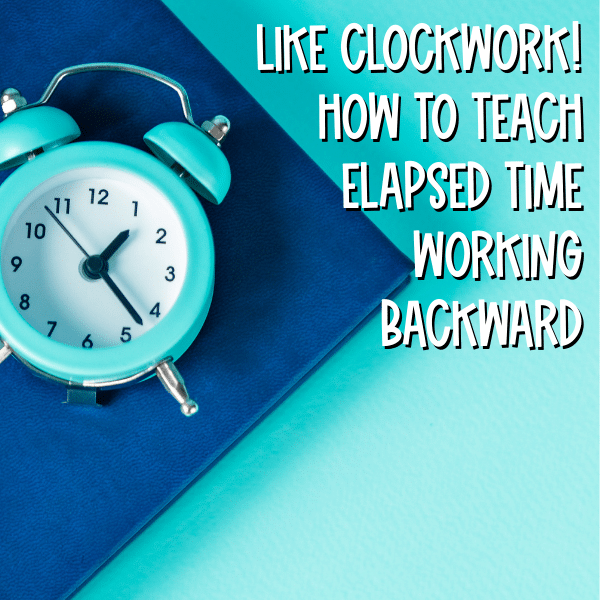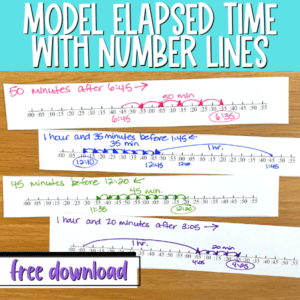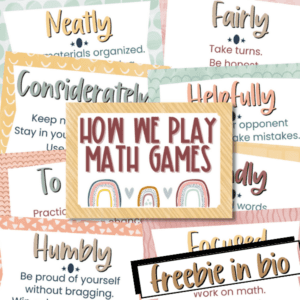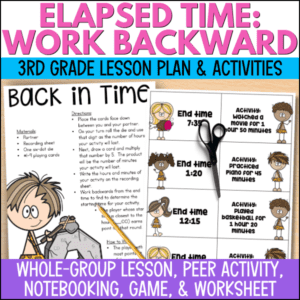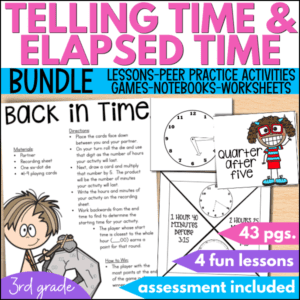When it’s time to teach elapsed time working backward the concept always looms on the lesson plan book like a mountain that waiting to be climbed. Every year I look at the mountain and think it looks too big, but every year we climb the mountain and find ourselves celebrating at the top! In this blog post, I’m sharing my favorite activities for teaching elapsed time working forward.
Step 1: Teach Elapsed Time Working Backward in a Whole Group Lesson
Before I teach elapsed time working backward, I start by reviewing the process of finding elapsed time by working forward. Then, ask, “What if we know when something ended, but need to figure out what time it started?” This prompts them to consider the reverse process – working backward.
Show students how to subtract time to find a starting point. Begin by subtracting whole hours, followed by half-hours, and then intervals of five minutes. Using clock manipulatives or clock number lines is a great way to give young students a concrete visual to help them understand how time flows when they need to work backward.
As always, teaching kids to check their work is a good idea. To check their work for elapsed time working backward, students simply need to count forward to the ending time to make sure they have the right answer.
As you teach elapsed time working backward, work through several examples together with your students so that they grow in their confidence.
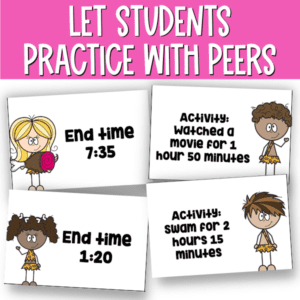
Step 2: Teach Elapsed Time Working Backward with a Peer Practice Activity
The next step to teach elapsed time working backward is to give students some opportunity to practice with classmates in a no-pressure and interactive environment. I use this set of elapsed time cards. I show the students that there are two types of cards, end time cards (cave girls) and activity cards (cave boys). I have students find a partner with an opposite card. Together the pairs should determine what time the activity started. Once they agree and have checked their work, they trade cards and go find a new partner.
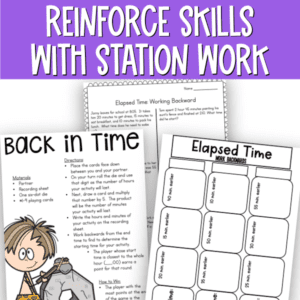
Step 3: Practice Finding Elapsed Time Working Backward in Station Work
Time traveling is hard work and takes practice, so after I teach elapsed time working backward and we’ve had time to practice together and the students have gained confidence, we break into small groups and rotate through math station work time.
Station 1:Interactive Notebooks
I like to use these elapsed time accordions. I have students cut out each accordion piece and fold in zig-zags to make an accordion with the ”ending time” on the front. On the inside squares, students solve the new time as the given number of minutes that have passed.
Station 2: Partner Games
The game I introduce to teach elapsed time working backward is called Time Travelers. I pair students up and give each pair a game board and a recording sheet for each player in the group. I also remind them of my expectations for math games. You can download your own copy of these math games behavior expectations.
Materials:
- Partner
- Recording sheet
- One six-dot die
- #1-9 playing cards
Directions:
- Place the cards face down between you and your partner.
- On your turn roll the die and use that digit as the number of hours your activity will last.
- Next, draw a card and multiply that number by 5. The product will be the number of minutes your activity will last.
- Write the hours and minutes of your activity on the recording sheet.
- Work backwards from the end time to find to determine the starting time for your activity.
- The player whose start time is closest to the whole hour (___:00) earns a point for that round.
How to Win:
- The player with the most points at the end of the game is the winner.
Station 3: Paper and Pencil Practice
Use your textbook assignment or the worksheet in this lesson to give students a chance to show you what they’ve learned about finding elapsed time working backward and provide you with a quick assessment of their understanding.
You can grab all these activities in this lesson on elapsed time working backward in my TPT store or grab the whole time unit on TPT or in my webstore. Happy teaching!

